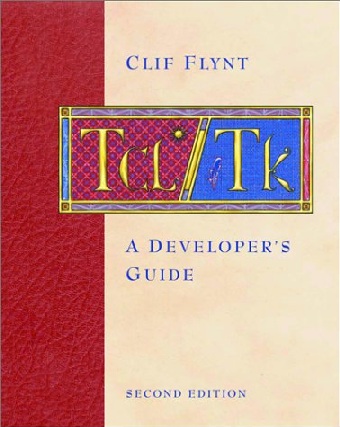| BOOK Table of Contents
|
- Tcl/Tk Features.
A quick overview of what Tcl/Tk offers the developer.
- The Mechanics of Using the Tcl and Tk Interpreters.
The low level functions of how to run the interpreter,
what the prompts are, etc.
- Introduction to the Tcl Language.
Describes the Tcl syntax, substitutions, data types, a subset of
the core commands, and offers short examples of use.
- File System, Disk I/O and Sockets.
Describes how to access the file system, perform I/O with
files, users, and client/server sockets.
- Using Strings and Lists.
How to find patterns and parse data in strings and lists.
Using regular expressions and modularizing with procedures.
- Building complex data structures with lists and arrays.
How to use the Tcl Array, how to examine the state of the interpreter,
and an example of building complex data structures (a splay tree) in Tcl.
- Procedure Techniques.
Using procedures to implement object oriented style programming in Tcl.
- Namespaces and Packages
How the namespace command command works, and how to use it for
data and procedure encapsulation. How to use the package command
for modules.
- Introduction to Tk Graphics.
The basic widgets, how to use the geometry managers.
- Using the canvas widget.
Things you can do with the canvas including finding and modifying
displayed items, binding actions to displayed items and creating
new pure Tk widgets.
- The text widget and htmllib.
How to use the text widget, and the htmllib package.
- Tk Megawidgets.
You can build complex widgets out of the basic building blocks.
This chapter describes how to do it.
- Writing a Tcl Extension.
One of Tcl's strengths is how easy it is to add new functionality
to the interpreter. This chapter explains how to do it.
- Extensions and Packages.
Descriptions of several popular packages with enough information
to start using them. Discusses incr Tcl, Expect, TclX, SybTcl, OraTcl,
MySQLTcl, VSdb, BWidgets, BLT, and the img extension.
- Programming Tools.
Descriptions of several application development tools, both freeware
and commercial. Includes code formatters, checkers, debuggers, GUI
generators, compilers wrappers extension generators and IDEs.
- Tips and Techniques.
A collection of tips and tricks and a list of common mistakes
|
|
| CDROM Contents
|
- Tcl/Tk HTML Tutorials in English, Russian, German, Turkish,
Japanese, Chinese, Dutch and Spanish.
- Brief How-To's on advanced Tcl/Tk topics
- TclTutor Release 2.0b6
- Real World Tcl/Tk Application articles
- Tclsh Spot articles from ;login: magazine
- Articles by Cameron Laird
- Tcl/Tk Man pages in HTML format
- Tcl & Tk Source Code distributions for Revision 8.4.1
- Tcl & Tk MS-Windows binary distributions for Revision 7.6p2 and 8.4.1
- Tcl & Tk Macintosh binary distributions for Revision 8.4.1
- Tcl & Tk Linux binary distributions for Revision 8.4.1
- Tcl & Tk Freebsd binary distributions for Revision 8.4.1
- ActiveTcl 8.4.1 distribution for Linux (x86 and IA64), Solaris, HPUX (PARISC and IA64) and MS-Windows
- TclKits for Linux, Mac, MS-Windows, Irix, AIX, Solaris, OpenBSD, NetBSD, and FreeBSD.
- StarKit construction tools and documentation.
-
[incr Tcl] Version 3.2.1 source
-
[incr Tcl] Version 3.2 (for Tcl 8.x) for MS-Windows
-
[incr Tcl] Version 3.1.8 (for Tcl 8.x) for Macintosh
-
[incr Tcl] Version 2.2 (for Tcl 7.6) for Macintosh
- TclX Source Revision 8.3
- TclX Source and Binaries for Revision 8.3 for Macintosh
- BLT 2.4z for Revision 8.3 MS-Windows binary
- BLT 2.4z for Revision 8.4 MS-Windows binary
- BLT 2.4z source
- Oratcl 2.5 for Tcl/Tk 7.6 - 8.1 for MS-Window & Unix
- Oratcl 4.0 for Tcl/Tk 8.x for MS-Window
- Oratcl 4.0 for Tcl/Tk 8.x Source
- Sybtcl 3.0rc2 source
- MySqlTcl 2.0rc15 Linux RPM and source
- VSDB pure Tcl database.
- BWidgets 1.4 and 1.6
- TclLib release 1.3
- Expect 5.21 for Windows NT
- Expect 5.38 source
- TclBridge for interprocess communications with Windows applications
- Img package with extra image format support from Jan Nijtmans.
- Frink & tclCheck from Lindsay Marshall - source & MS-Windows binaries
- TclParse code checker
- Tcl Cruncher
- SWIG Interface generator
- Tuba GUI-based Debugger
- TdDebug GUI-based Debugger
- Spec-Tcl GUI builder for Macintosh, Unix and MS-Windows
- WISQL
- TkConsole
- Widget package
- get 1.0 extension template from Jean-Claude Wippler
- Extension skeleton
- Tcl/Tk Style guide and Engineering Manual
- Paul Raines' Tcl/Tk reference handbook
|
|


![]()
![]()
![]()
![]()